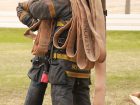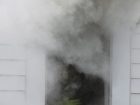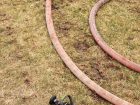
Features
Back to basics: September 2019
Pulling the right size of hose line
August 20, 2019
By Mark van der Feyst
For the last little while, I have been focusing on SCBA and the handicaps that we find ourselves stuck with – and in – when not well-versed with the equipment. I am going to change gears this month and turn my attention to hose lines and pulling the right size hose line the first time.
As basic of an operation or task as this is, many times we find ourselves not pulling the right size hand-line and defaulting to our staple hose line for every fire that we fight. The staple hose of the fire service is the one-and-a-half-inch or 38-millimetre-size hose or the one-and-three-quarter-inch or 45-millimetre-hose. This size hose is an easy size for most firefighters to handle based on water flow and nozzle reaction.
Depending upon what type of nozzle is affixed to the end of the hose, the water flow and nozzle reaction will vary. The two basic types of nozzles are the smooth bore and the combination nozzle.
If the smooth bore nozzle has a 15/16-inch-tip on the end it will deliver about 180-gallons-per-minute (GPM) at 50-pounds-per-square-inch (PSI). The nozzle reaction on this type of nozzle is around 69 pounds.
With the combination nozzle, it can be programmed to flow a fixed amount of water at a certain nozzle pressure – 165 GPM at 50 PSI or 180 GPM at 75 PSI, for example. The nozzle reaction for these types of nozzles will vary from 69 pounds to about 80 pounds of force.
The automatic combination nozzle can be programmed the same way with a set pressure required at the tip like 75 PSI or 100 PSI and the flow will vary depending upon the amount of water being provided to it from the pump. It is also very mobile in terms of advancement. A firefighter or two can easily maneuver this size hose line into a structure.
With the amount of water that is inside the hose in terms of gallons, the water weight of the hose is not that heavy and can easily be advanced. The one-and-a-half-inch or 38-millimetre hose is extremely easy to maneuver as compared to the one-and-three-quarter-inch or 45-millimetre hose.
The downside to these two hose sizes is the amount of water flow that is being produced – is it enough to overcome or combat the fire that is being presented to you? Many times, these two size hose lines will be adequate to produce enough water to overcome the heat release rates, the energy production, the thermal production of heat and the unburned products of combustion. But there are times when this is not the case. We seem to always pull these two size lines for every fire that we attend.
Why do we do this? It is because of our programming – we pull our pre-connected hose lines as our first hose lines off the truck and they are usually always one-and-a-half-inch or 38-millimetre or one-and-three-quarter-inch or 45-millimetre. It is our default action.
So, what if the fire needs more water? What do we do then? A lot of times we pull off multiple hose lines to help with the demand of more water on the fire. This is an okay plan if we have the manpower to do this and the water supply available to supply all these extra hose lines. But it is not very effective or efficient in our initial actions with limited manpower upon arrival.
A different size of hose is often pulled off as the first attack line. It is the traditional two-and-a-half-inch or 65-millimetre-size hose line. This size hose line has been in existence since the dawn of the fire service and it has performed faithfully and very adequately. Attached to this hose line is a fixed-flow combination nozzle – it was programmed for 250 GPM at 50 PSI. The nozzle reaction for this size hose is going to be between 75 and 85 pounds of force. The water weight of this size hose line is heavier than the smaller sizes because you are almost doubling the size of the hose and the amount of water that it is able to hold, so it is not the most desirable hose line to pull off the truck first.
Many firefighters hesitate to pull off the two-and-a-half-inch or 65-millimetre-size hose line because they are either afraid of it or not used to handling it and think of it as a defensive weapon only and not an offensive weapon. When there is big fire, you will need big water and this size hose line will deliver a massive knockout punch with water delivery.
With first-arriving crews on the scene of a structure with large fire, effectiveness and efficiency will be gained by pulling the right size hose line – which in this case might be the two-and-a-half-inch or 65-millimetre-size hose line.
There is an old saying that still bears true to this day; small fire = small water, big fire = big water. With a proper size-up, the first-arriving officer can determine that either small water or big water is needed. To overcome the fears or misconceptions of the larger hose lines and pulling them off as an offensive weapon, training will be the answer.
There are a few different techniques that can be used to aid with pulling off the hose line, flaking it out and advancing it into a structure with just two firefighters. It does not take an army of firefighters to move or advance a two-and-a-half-inch or 65-millimetre-size hose line.
By practicing these different techniques, firefighters will become more proficient with this certain skill and, in the long run, become more effective and efficient with their actions.
Mark van der Feyst has been a member of the fire service since 1999 and is a full-time firefighter in Ontario. Mark teaches in Canada, United States and India, and is a FDIC instructor. He is the lead author of the Residential Fire Rescue book.
ContactMark at Mark@FireStarTraining.com.
Print this page


